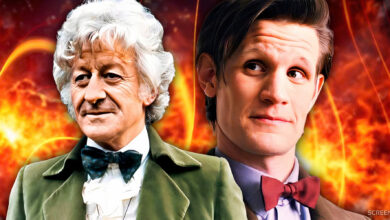10 Doctor Who Monster Redesigns, Ranked Worst To Best
Over the years, the modern era of Doctor Who has introduced several new villains and original monsters to keep audiences on the edge of their seats, but the most exciting creatures are always the ones returning from the original series. Classic Who had some truly terrifying monsters whose designs were hugely ahead of their time, despite the show’s fairly low budget that held back the practical effects and makeup. However, when the majority of these creatures made their return in the modern era, they were given complete redesigns.
Doctor Who has some cute monsters, it has some friendly monsters, but the majority of the show’s alien species have turned out to be fairly troublesome for the Doctor during his travels through time and space. And despite his best efforts, many of these creatures have come back time and time again to cause trouble for the Time Lord. This was one of the most exciting features of the Doctor Who revival when it started in 2005, and it’s still exhilarating when monsters are given a fresh lick of paint today.
The Autons
First Appeared In “Spearhead From Space”
The Autons are one of Doctor Who’s longest-running villains, so it’s no surprise that showrunner Russell T. Davies decided to give them the very first appearance in the rebooted Doctor Who’s pilot episode. They’re a species of artificial life form created by the Nestene Consciousness to hide in plain sight and serve as sleeper agents for the consciousness’ inevitable invasion of humanity.
In both the classic and rebooted shows, the Autons took the form of plastic shop-window mannequins. Their classic design was slightly more exaggerated and noticeable than their rebooted design, which was more subtle and didn’t have too many identifying features beyond their plastic form. It was one of the show’s least dramatic monster redesigns, and consequently one of the most forgettable.
9The Macra
First Appeared In “The Moonbase”
The Macra weren’t particularly well-known before they were rebooted in Doctor Who’s third season, but their return was a welcome surprise for long-term fans of the show. The species belongs to an empire of large crustaceans who thrive in humanity’s unclean gasses, turning them poisonous to humans. This allowed them to live in spaces that humans physically couldn’t enter, allowing them to remain undetected for years.
The Macra later returned in Gridlock, a Doctor Who episode featuring one of David Tennant’s best performances as the Doctor. In the story, the crab-like monsters had become even larger and more terrifying, though their physical form was quite similar. They had maintained their ability to create poisonous gas, which caused the endless stream of traffic that the Doctor had to navigate in that episode. Although they were defeated fairly easily, their increased scale was a treat to see on-screen.
The Sea Devils
First Appeared In “The Sea Devils”

Doctor Who’s reimagined Sea Devils are one of the most recent redesigns, and it’s long past time for these iconic villains to make their return. The aliens are cousins of the Silurians, and lived on Earth before humanity came to inhabit the planet. They made their debut in The Sea Devils alongside the Third Doctor, but it took a while for the show to bring them back. It wasn’t until series 12’s The Timeless Children that audiences were given a glimpse of their updated design, and the show seemed to have learned the wrong lesson from the Silurians.
Instead of making the creatures more humanoid and familiar, showrunner Chris Chibnall opted for a more loyal and authentic adaptation of their original form – but the result was somewhat goofy and misjudged. He maintained the tall prosthetics and reptilian features that made them so iconic in the first place, but merely updated them with the increased budget. It’s one of the bolder decisions that was made in Chibnall’s turn as showrunner, and it didn’t quite pay off.
7The Zygons
First Appeared In “Terror Of The Zygons”
Although it took a while for Doctor Who to bring the Zygons back after the show was rebooted, their new design was certainly worth the wait. Their new form was very similar to their classic look, but the show’s increased budget and more advanced prosthetics gave them much more detail and intricacies. Where the monsters had previously been constructed using red suits and headpieces, the new Zygons were almost entirely makeup and prosthetics, which helped them look both humanoid and unfamiliar at the same time.
It was also fitting that they returned at the same time as Tom Baker, the actor whose iteration of the Doctor they’re most firmly associated with
The Zygons made their first reboot appearance in Doctor Who’s 50th anniversary special, The Day of the Doctor. This was the perfect episode to bring them back, as it was a real celebration of Doctor Who’s history and the Zygons certainly deserve their recognition in that narrative. It was also fitting that they returned at the same time as Tom Baker, the actor whose iteration of the Doctor they’re most firmly associated with. With “Terror of the Zygons” now removed from BBC iPlayer, the updated appearance is all that remains of the classic monsters.
6The Ice Warriors
First Appeared In “The Ice Warriors”
The Ice Warriors first appeared alongside the Second Doctor in their Doctor Who debut, and they stuck around for many years after that. The creatures quickly became a fan favorite, popping up in several stories and causing trouble for the Doctor and his companions on several occasions. But despite their popularity, the Ice Warriors didn’t appear in the rebooted Doctor Who until its seventh season, when they were updated for the modern age with an interesting tweak.
Instead of the classic armor that the Ice Warriors were seen in throughout Classic Who, the rebooted show introduced the aliens with biomechanical armor, leading to Matt Smith’s Doctor referring to them as “cyborgs.” This was an interesting change to the creatures’ backstory, seemingly retconning the monsters that were included in the original show. The Ice Warriors have a complex backstory, and their rebooted design seemingly changed that in subtle ways to make them even more intimidating.
5The Sontarans
First Appeared In “The Time Warrior”

The Time Warrior has quickly become one of the most beloved episodes of Classic Who, and there’s good reason: not only does it mark the first appearance of the Sontarans, but it also includes the first mention of the Doctor’s home planet Gallifrey and the first adventure with fan-favorite companion Sarah Jane Smith. As such, the Sontarans became hugely important figures in Doctor Who’s history, and their reveal in the rebooted show’s fourth season was a huge moment for the show’s fans.
While the Sontarans have always been some of Doctor Who’s most frightening and fierce villains, their classic design didn’t always reflect their power. The low-budget costumes and messy prosthetics often revoked much of their fear-inducing power, but this disappeared with their modern redesign in The Sontaran Stratagem. With their updated armor and more humanoid appearance, the Sontarans became frightening once again and cemented themselves as an all-time great Doctor Who villain.
4The Silurians
First Appeared In “Doctor Who And The Silurians”
Doctor Who’s major redesign of the Silurians ranks among the show’s most controversial choices since its reboot, as the creatures were given a completely different appearance from their classic form. In the original show, the Silurians were brown, scaled aliens with large eyes and pointed skulls that gave them a creepy, uncanny appearance. But when Doctor Who finally brought them back in series 5, the Silurians were much more humanoid: their faces were no longer prosthetics, but rather the actors’ faces painted green.
The Silurians were distant relatives of the Sea Devils, and their history in the show was a long and complicated one. Their classic form was iconic, one of Doctor Who’s most recognizable alien designs – therefore, many fans were unhappy with their new look. However, the rebooted Silurians’ more humanoid appearance actually serves a purpose in the story. It helps the other characters see themselves in the aliens, which pushes home the episode’s message about acceptance and, subtextually, xenophobia.
3Davros
First Appeared In “Genesis Of The Daleks”
Davros is one of the few individual Doctor Who characters who survived the transition from the classic to the rebooted series, making his return in the series 4 finale The Stolen Earth. In the episode, Davros was given a totally reimagined look that saw him somewhere between human and Dalek, using the show’s improved prosthetics to really highlight the fact that his body has been corrupted and deteriorated over the years. It’s a much less clean and refined version of the character, but that fits perfectly with his backstory.
Doctor Who has also redesigned Davros again since his last appearance, with Russell T. Davies claiming that he wanted to move away from associating the evil character with his disability in the future.
Doctor Who has also redesigned Davros again since his last appearance, with Russell T. Davies claiming that he wanted to move away from associating the evil character with his disability in the future. Instead, audiences were treated to a new version of the character prior to his confinement to a chair, which is a version of Davros that’s never been explored before.
2The Cybermen
First Appeared In “The Tenth Planet”
The Cybermen are safely among Doctor Who’s most recognizable and iconic characters, but the monsters have been through several different appearances throughout the years. Whether it’s the Mondasian Cybermen that appeared in The Tenth Planet or the Alternate-Reality Cybermen from Rise of the Cybermen, there’s always something new about the villains that help them stand out from all their previous forms.
The Cybermen were one of the first classic villains that Doctor Who brought back post-revival, and it’s hard to imagine the show without them. They’ve starred in almost every season of the show since their return in season 2, and they’ve been responsible for the deaths of several beloved companions and friends. Their designs keep getting increasingly unique and frightening, which fits perfectly into their in-universe mantra of “upgrading” themselves over and over again.
1The Daleks
First Appeared In “The Daleks”

The Daleks starred in several classic Doctor Who stories, helping them develop their current reputation as the most iconic and memorable villains in the entire series. Their first adventure, aptly named The Daleks, introduced the creatures as controlling, dictatorial creatures who wanted their entire planet of Skaaro for themselves. Each following story cemented this reputation, making them more and more dangerous, until the rebooted series explained their involvement in the Time War and finally proved them to be the Doctor’s greatest enemy.
When the Daleks returned in series 1’s Dalek episode, they had a strong new design that stuck closely to their original form while updating their armor and voices to make them seem even stronger and more intimidating than in classic Doctor Who. They were later redesigned once more in Victory of the Daleks with bright colors and independent personalities, which gave the Daleks unique identities rather than merely referring to them as a unit.
















